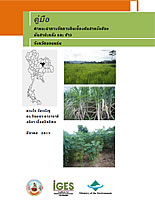Although it is widely acknowledged that forests provide critical ecosystem services for human survival and well-being, in the Asia-Pacific region forests are being converted to other land uses and degraded at alarming rates. One underlying factor for this destruction of forests is market failure. Forests are cleared for other land uses or degraded...
- Clear all
- Topic: (-) Forests
- Region/Country: (-) Australia
- Region/Country: (-) Thailand
- Region/Country: (-) United Kingdom of Great Britain and Northern Ireland
Results 1 - 10 of 24 (Sorted by date)
In PLoS ONE
Both hydropower dams and global warming pose threats to freshwater fish diversity. While the extent of global warming may be reduced by a shift towards energy generation by large dams in order to reduce fossil-fuel use, such dams profoundly modify riverine habitats. Furthermore, the threats posed by dams and global warming will interact: for...
In Applied Geography
This study provides a computationally-simple method to annually update existing national forest maps and model future forest change. It involves integrating national forest maps and global tree cover maps to monitor annual forest change, and then modeling future change by linear extrapolation of the historical trend.
In Journal of ISSAAS
Biofuels are often presented as an environmentally friendly alternative to fossil fuels, however, empirical analysis that is widely reported in the literature shows that biofuel production can have negative environmental and social impacts. The potential for these negative impacts can be avoided through careful planning of biofuel feedstock...
In ISPRS International Journal of Geo-Information
A new method was developed for mapping forest, agricultural, and urban land cover using remote sensing imagery. It is designed to better detect small land cover objects (e.g. small forest or agricultural patches) and monitor their change (e.g. fine-scale deforestation) using freely-available satellite imagery.
In ISPRS International Journal of Geo-Information
This study evaluated the effects of image pansharpening on Vegetation Indices (VIs) in an agricultural area of Thailand, and found that pansharpening was able to downscale single-date and multi-temporal VI data without introducing significant distortions. The downscaled (15m resolution) VI values can be used for estimating above-ground biomass...
アジア太平洋地域の発展途上国で進んでいる森林減少の最大の要因は、違法かつ持続可能でない伐採である。違法伐採によって木材輸入国が安価な木材を大量に輸入できる一方で、輸出国の自然環境、森林の管理・経営(ガバナンス)、そして森林に依存して暮らしている人々の生活が犠牲になっている。木材輸入国においても発展途上国の適正な森林管理を促進する義務があることを認識して、現在多くの政府が合法で持続可能な木材の調達を支援する公共調達政策を導入している。これは、持続可能な開発を進める上で国際貿易を活用する極めて重要な一歩である。 本ポリシー・ブリーフは、日本、英国、オランダ及びフランスで実施されている木材公共調達政策を比較し、各国の手法の共通点と相違点を検証しながら...





